NVIDIA
GeForce FX 5950 Ultra,
GeForce FX 5700 Ultra,
GeForce FX 5700,
GeForce FX 5600XT 128bit
|
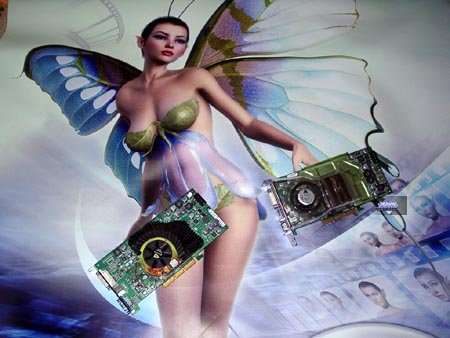
CONTENTS
-
Video cards features
-
Testbed,
test tools, 2D quality
-
Test results: Quake3 ARENA (speed
& quality)
-
Test results:
Serious Sam:
The Second Encounter (speed & quality)
-
Test results:
Return to
Castle Wolfenstein (speed & quality)
-
Test results: Code
Creatures
DEMO (speed & quality)
-
Test results:
Unreal Tournament
2003 (speed & quality)
-
Test results:
Unreal II:
The Awakening (speed & quality)
-
Test results:
RightMark
3D (speed & quality)
-
Test results:
TRAOD: Benchmarking
in paris5_4
-
Test results:
TRAOD: Benchmarking
in paris1c
-
Test results:
TRAOD: Benchmarking
in paris2g
-
Test results:
HALO: Combat
Evolved (speed & quality)
-
Test results:
Half-Life2(beta):
ixbt07 benchmark (speed
& quality)
-
Test results:
Half-Life2(beta):
coast benchmark (speed & quality)
-
Conclusion
Following ATI with its RADEON 9800 XT and 9600 XT, NVIDIA announces
a new line of products. If you think that they simply overclocked the
old
models, you will be partially right. For the middle sector NVIDIA
produces
not the overclocked NV31 but a redesigned processor codenamed
NV36.
First of all let's look at the new line:
-
NVIDIA GeForce FX 5950 Ultra - former NV38, GeForce FX 5900 Ultra
overclocked
up to 475/475 (950) MHz (recommended price of $399 or 499: question is opened), positioned against
ATI RADEON 9800 XT;
-
NVIDIA GeForce FX 5700 Ultra - former NV36, it's a half of the NV38: 4
rendering pipelines, 4 texture units, 3 vertex pipelines, 475/450 (900)
MHz (recommended price of $199), positioned against ATI RADEON 9600 XT;
-
NVIDIA GeForce FX 5700 - the same NV36, but the clock speeds are lower
- 425/275 (550) MHz (recommended price of $149), positioned against ATI
RADEON 9600 or 9600 PRO;
-
NVIDIA GeForce FX 5600XT 128bit - the old NV31 (FX 5600)
based on simpler PCB with reduced clock speeds of 230/200 (400) MHz
(recommended price of $99), positioned against ATI RADEON 9600 SE.
64bit cards are also expected (at a lower price).
So, there are three new video cards, the 5600XT is just a slower
version
of the FX5600 meant to press the FX5200 down to the lower-price niche
and
competes against such ATI's products as RADEON 9600 SE. However, much
will
depend on the price. It's a bit difficult to oppose the cards because,
for example, the recommended price for the FX 5700 is between the
RADEON
9600 and RADEON 9600 PRO. The RADEON 9600 SE may also fall below the
$80
mark bringing the RADEON 9600 close to $100.
That is why we oppose the cards the way they are approximately
positioned
on our local market. The thorough comparison can be found in our future
3Digest.
We had only TWO video cards in our lab: 5950 Ultra and 5700 Ultra.
The
speed results of the FX 5700 are obtained by reducing the clock speeds,
like the scores of the FX 5600XT 128bit (slower FX 5600). That is
why these figures
are approximate, though NVIDIA's products seldom differ in speed if the
cards of the same architecture and different default clock speeds are
tested
on the same frequency.
As to the NV38, it makes no sense to examine its architecture half a
year after the release of the NV35. See the details in this review. Here are its brief specs:
Specification
-
0.13 micron process, copper connections
-
135 M transistors
-
3 geometry processors (exceed the specs of the DX9 VS 2.0)
-
4 enhanced pipelined pixel processors. Instead of the expected 8 pixel
processors NVIDIA leaves the same 4 processors. Each of them is
equipped
with two texture filtering units, two integer-valued floating-point
ALUs
and one simply floating-point ALU. It results to three floatong-point
operations.
Such configuration allows up to 12 pixel operations per clock.
-
AGP 3.0 (8x) system interface
-
256-bit DDR1 interface (!)
-
Intellisample HCT (High Compression Technology) is the extension of the
Intellisample in NV30 (local memory optimization technology).
-
Tile operations: caching, compression, Early HSR, Early z Cull
-
UltraShadow technology - speeds up rendering of stencil shadows (they
are
called stencil shadows because the stencil buffer if used much when
they
are generated) at the expense of limitation of the scene depth for
objects
processed.
-
Support for high-precision integer-valued formats (10/16 bits per
components)
and high-precision floating-point formats (16 and 32 bits per
components)
for texture and frame buffers.
-
Through accuracy of all operations - 32-bit floating-point arithmetic
(128-bit
color depth supported)
-
New optimized anisotropy algorithm, when enabled by user, reduces the
performance
drop (fps) without quality degradation
-
Anisotropy quality up to 8x of bilinear filtering, i.e. up to 32
discrete
texture samples per one texture fetch
-
AA hybrid modes - 8x and 6xS
-
Frame buffer compression allows reducing the performance drop with FSAA
enabled
-
Two integrated 400 MHz RAMDACs
-
Integrated interface for external TV-Out chip
-
Three integrated TDMS channels for external interface DVI chips
The NV38 is the same NV35 which meets stricter requirements. The
engineers
at NVIDIA and TSMC had half a year to improve the production, and now
at
the output equal to the 5900Ultra they get chips working stably at 475
MHz instead of 450 MHz. The card's also equipped with faster memory.
It's
quite possible that the GeForce FX 5900 Ultra will be taken out of
production
to give way to the 5950 Ultra.
The NV36 is a new solution. Have a look at the comparison table:
| |
NV36 |
NV31 |
NV34 |
| Technology, nm |
130 |
130 |
150 |
| Transistors, M |
85 |
75 |
47 |
| Pixel pipelines |
2/4(1) |
2/4(1) |
2 |
| Vertex pipelines |
3 |
2 |
1 |
| Texture units |
4 |
4 |
4 |
| Core clock, MHz |
475 (Ultra) |
400 (Ultra) |
250 |
| Memory bus, bits |
128 (DDR II) |
128 (DDR) (2) |
128 (DDR) |
| Memory bus clock (eff.) MHz |
900 (Ultra) |
800 (Ultra) |
400 |
| Pixel shaders |
2.0+ |
2.0+ |
2.0+ (3) |
| Vertex shaders |
2.0+ |
2.0+ |
2.0+ |
| Memory bandwidth, GB/s |
14.4 |
12.8 |
6.4 |
| HSR |
Yes |
Yes |
Yes |
| Early Z test |
Yes |
Yes |
Yes |
| Z compression |
Yes |
Yes |
Yes |
| Color compression in MSAA modes |
up to 1:4 |
up to 1:4 |
No |
| Hardware geometry unit |
yes |
yes (4) |
yes (4) |
| RAMDAC, MHz |
2x400 |
2x400 |
2x350 |
| TV-out |
integrated |
external |
external |
| DVI |
integrated |
integrated |
integrated |
| Package |
FCPGA |
BGA (5) |
BGA (5) |
| External power supply |
obligatory |
desired (Ultra) |
optional |
Note:
-
NV31 supports 4x1 (pipelines x texture units) or 2x2.
-
DDR2 supported
-
There's some difference between pixel shaders of NV34 and NV31, but
both
comply with the 2.0 standard.
-
The hardware geometry processors of the NV31 and NV34 have the same (!)
computational performance, twice lower than that of the NV30, and in
the
NV36 the performance is higher at the expense of three pipelines.
-
NV25 compatible
The NV36 looks stronger than the NV31. The tests will show how it
helps.
Note that the GeForce FX 5700 Ultra card is equipped with the DDR-2 (!)
memory and its recommended price is only $199! Either the price for the
DDR2 fell down much or NVIDIA found a new way to cut the cost price.
But
this is a question of the design.
Cards
| NVIDIA GeForce FX 5950 Ultra |
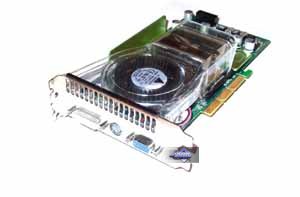
|
| NVIDIA GeForce FX 5700 Ultra |
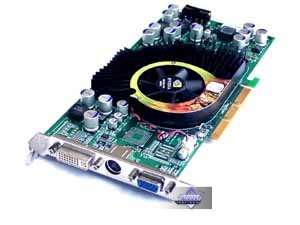
|
The cards have AGP x8/x4/x2 interface, the FX5700
Ultra has 128 MB DDR-2 SDRAM memory in 8 chips on both PCB sides,
FX5950 Ultra has 256 MB DDR SDRAM in 16 chips on both sides.
|
| NVIDIA GeForce FX 5950 Ultra |
| Hynix 2ns memory chips (corresponds to 500
(1000) MHz), memory clocked
at 475 (950) MHz, GPU at 475 MHz. 256 bit memory bus. |

|
| NVIDIA GeForce FX 5700 Ultra |
| Samsung (GDDR2) 2.2ns memory chips (corresponds
to 450 (900) MHz),
memory clocked at the same frequency, GPU at 475 MHz. 128 bit memory
bus. |

|
| Comparison with the reference
design, front view |
| NVIDIA GeForce FX 5950 Ultra |
Reference card NVIDIA GeForce FX 5900 Ultra |

|

|
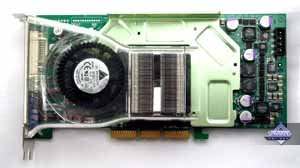
|
| NVIDIA GeForce FX 5700 Ultra |
Reference card NVIDIA GeForce FX 5600 Ultra |

|

|

|
| Comparison with the reference
design, back view |
| NVIDIA GeForce FX 5950 Ultra |
Reference card NVIDIA GeForce FX 5900 Ultra |

|

|
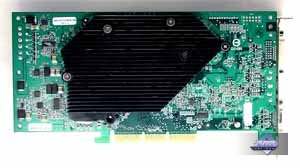
|
| NVIDIA GeForce FX 5700 Ultra |
Reference card NVIDIA GeForce FX 5600 Ultra |

|

|

|
|
Here's the reference GeForce FX 5700 based card:

The card is based on the design close to the FX 5600,
and judging
by its specs it will have the 3.6ns memory in TSOP package.
The design of the FX5950 Ultra is slightly altered compared to
the FX
5900 Ultra, in particular, where the power supply unit is placed. The
card
looks bulky because of the cooler.
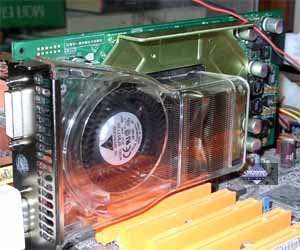
Have a look at two flagships of today's 3D graphics sector
(RADEON 9800
XT above, GeForce FX 5950 Ultra below):

The cooler reminds the FlowFX - the cooler that spoiled the
reputation
of the NV30. The first PCI slot is not available...

But it's a different cooler:
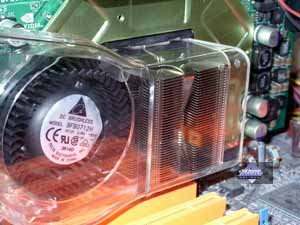 
Air is drawn from inside of the PC case, at the backside of
the heatsink,
i.e. the air flow does not change its direction, making the cooler
quieter
compared to the FlowFX. But it's still noisy as the speed of rotation
is
pretty high and air goes through a turbine.
If you are interested in the cooler's design look at how we
assembled
it:

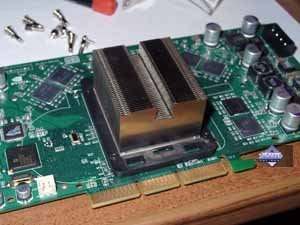

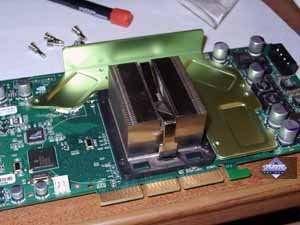
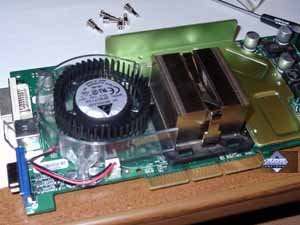
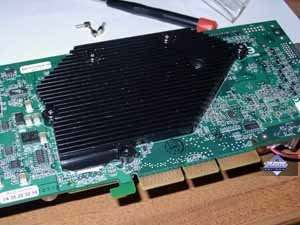

And now comes the NV38 GPU itself:

The chip was manufactured at 27th week, 2003, i.e. in the
middle of the
summer. Also you can see that figures "5950" are simply added on top.
It
proves that it is the same GeForce FX 5900 Ultra which just reliably
operates
at 475 MHz.
The card's equipped with the Philips 7108 coder controlling
VIVO:
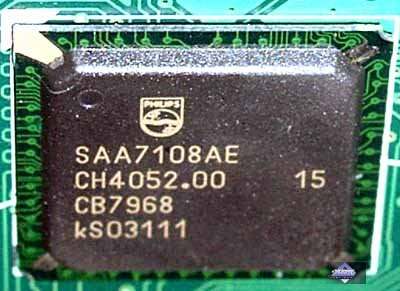
Quality of such multimedia functions were examined in the
previous reviews.
The NV36 design looks more interesting. The PCB of the GeForce
FX 5700
Ultra is unique and has only several traits common with the GeForce FX
5600 Ultra. The card has GDDR2 memory instead of the traditional DDR.
Such
chips, only faster samples, were also installed on the GeForce FX
5800/5800
Ultra.
That PCB was very complicated and NVIDIA had to place orders
for cards
with third manufacturers, and its partners actually received finished
solutions.
The current situation is simpler but the PCB is still complicated as
the
GDDR2 required good protection from pickups:
 
It's clear that the memory section is entirely screened on
both PCB sides.
In fact, the card looks very similar to the NV30: GRRD2, 128bit bus,
PCB
screening, clock speeds... everything but the price. This time the
recommended
price is $199. I do not believe that all the components got twice
cheaper...
Either those cards weren't so expensive (NVIDIA just tried to hide it),
or this time NVIDIA knowingly incurs losses.
I don't understand why they use GDDR2 memory, which is more
expensive
and requires dearer PCB design, for the clock speeds of 450 (900) MHz
if
there's 2.2ns memory of the DDR standard (the GeForce FX 5900 uses
exactly
this memory type). Is GDDR2 cheaper than DDR? - I don't think so.
The cooler is pretty compact, and the card takes only one
slot:
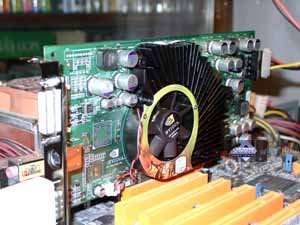
The cooler consists of two parts located on both side.
 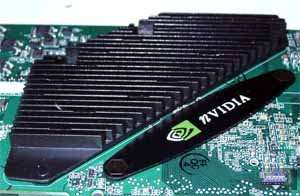

The cooler mount is reliable, and the cooler itself works
quietly.
Here's the chip.
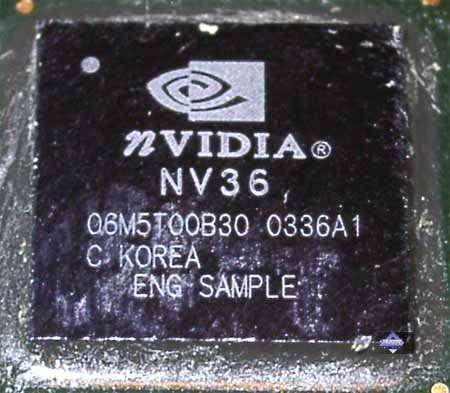
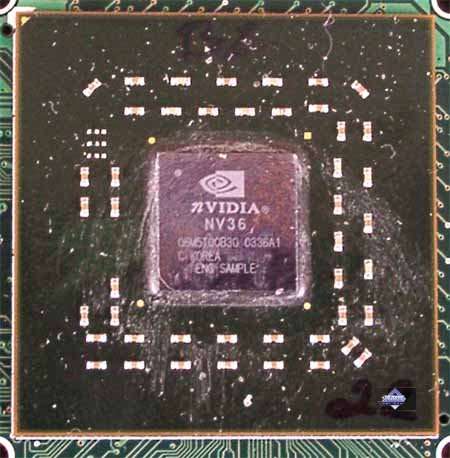
It's the first time we see the FCPGA packed processor with the
cap removed
made
by NVIDIA. I tried to remove the cap from the GeForce FX 5600 Ultra
and the chip easily reached 500 MHz (at the default clock speed of 400
MHz). Probably, the guys at NVIDIA arrived at the same conclusion that
it's better to cool the die directly.
Also note that the NV36 is produced at IBM's plants, and
NVIDIA says
that the first revision works pretty well.
In the overclocking mode the NV38 reached 520/1050 MHz and the
NV36
demonstrated the impressive jump to 600/1100 MHz! It means that the
chip
has an excellent potential (the percentage of valid chips for 475 MHz
is
probably high), and the PCB is competently designed as the GDDR2 memory
managed to speed up by 100 MHz in spite of its high temperature. The
cards
were equipped with additiional fans.
Testbed and drivers
Testbed:
-
Pentium 4 3200 MHz based computer:
-
Intel Pentium 4 3200 MHz CPU;
-
DFI LANParty Pro875 (i875P) mainboard;
-
1024 MB DDR SDRAM;
-
Seagate Barracuda IV 40GB HDD;
-
Windows XP SP1; DirectX 9.0a;
-
ViewSonic P810 (21") and ViewSonic P817
(21")
monitors.
-
NVIDIA drivers 52.16 (WHQL!).
VSync off, S3TC off in applications.
The drivers v5x.xx provide the following panels of settings:
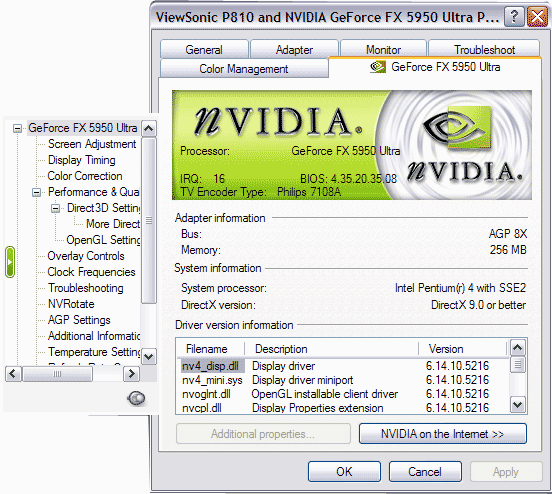
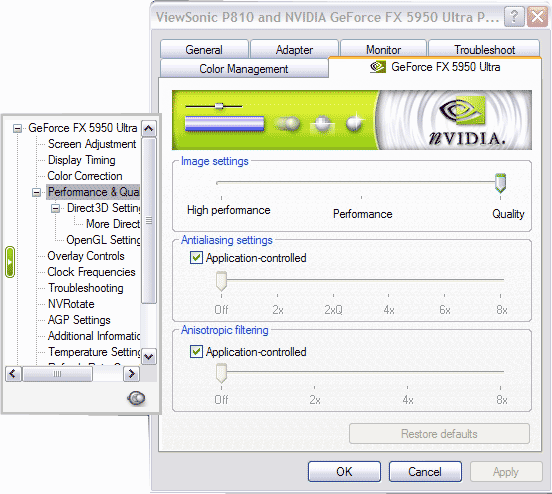
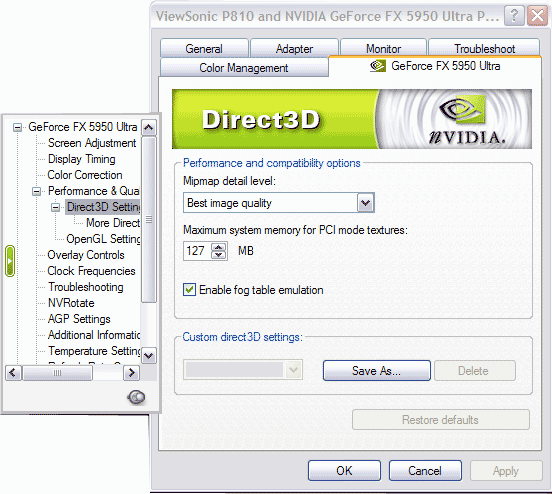
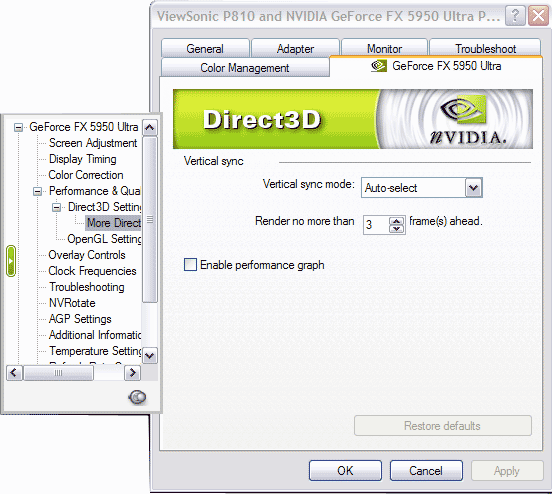
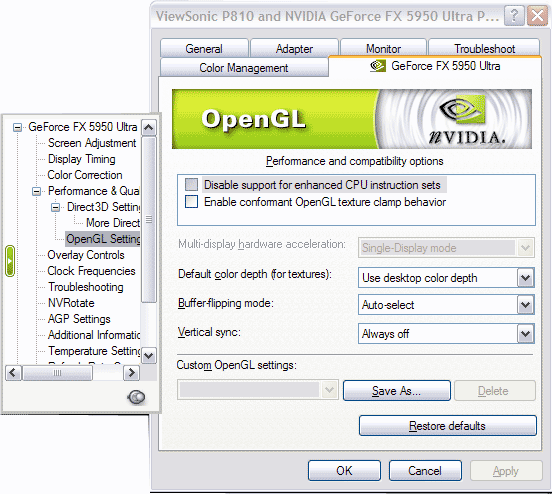
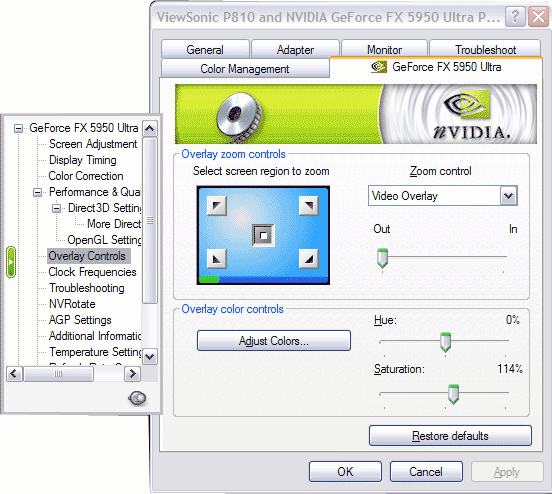
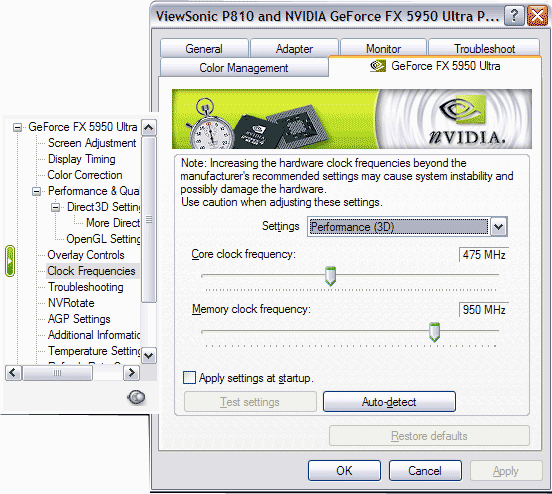
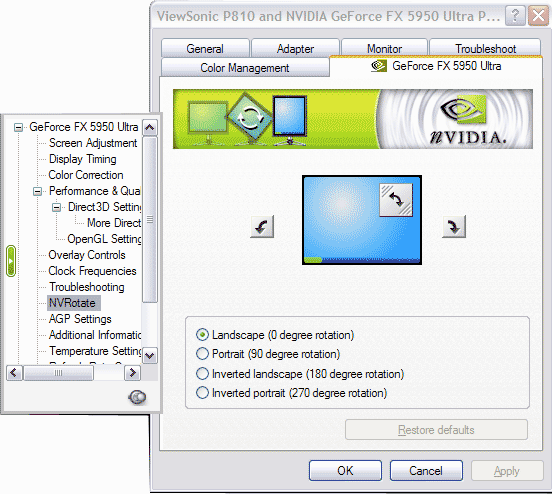
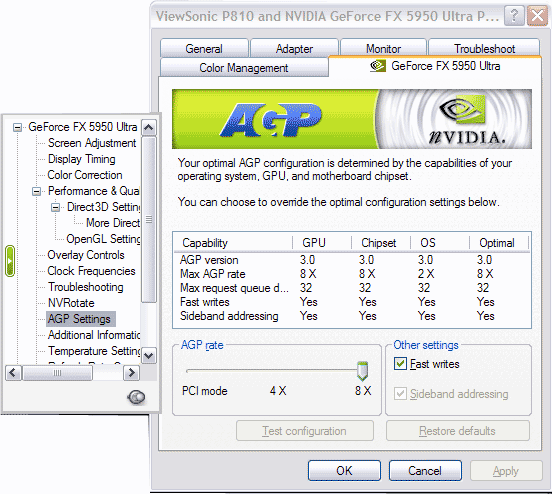
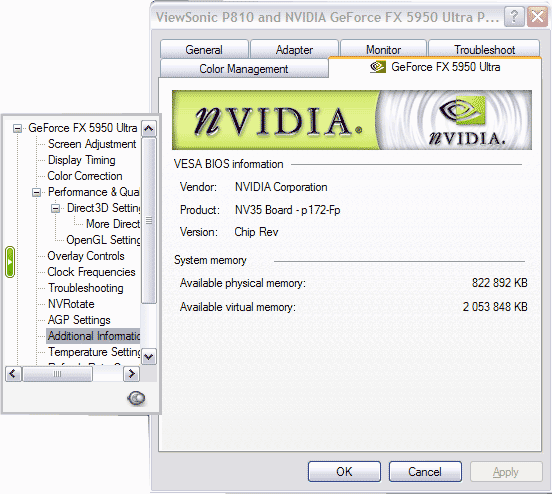

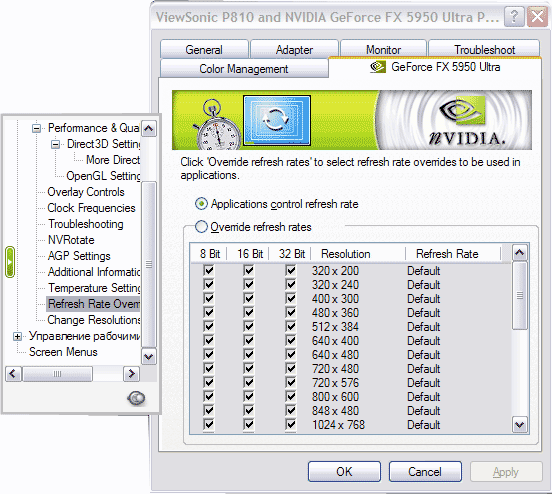
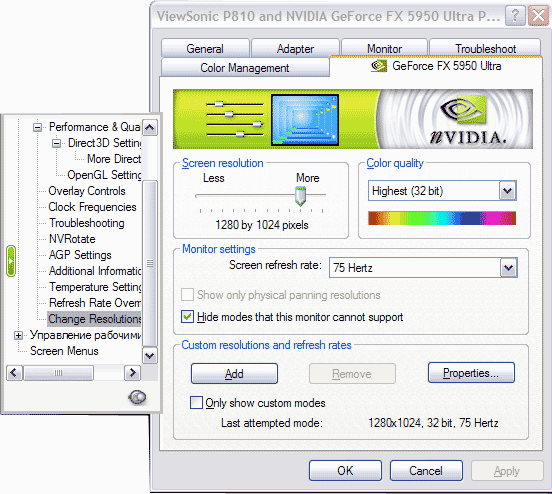
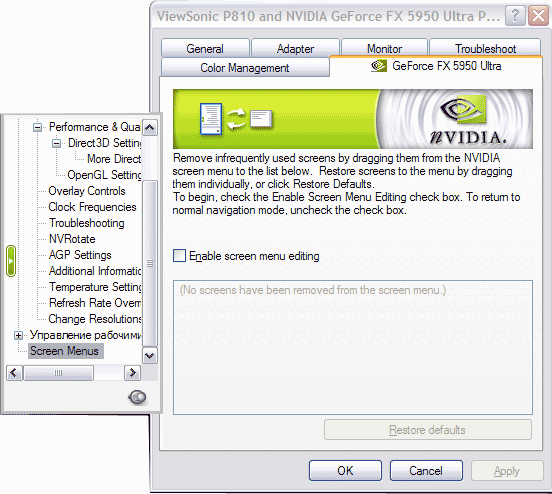
The new version gives you flexible tools to manage the AA and
anisotropy
(you can let the application decide to enable or disable them, or do it
yourselves), has Quincunx AA mode changed into 2xQ. Besides, the clock
speeds at different resolutions now change simultaneously for D3D and
OpenGL.
The new version also offers finer adjustment of the clock speeds and
resolutions
in 2D. In the menu editor you can hide unnecessary menu options. The
other
features are similar to the versions 4x.xx.
Test results
Before we start examining 2D quality, I should say there are
no complete
techniques for objective 2D quality estimation because:
-
2D quality much depends on certain samples for almost all modern 3D
accelerators;
-
Besides videocards, 2D quality depends on monitors and cables;
-
Moreover, certain monitors might not work properly with certain video
cards.
With the ViewSonic P817 monitor and BNC Bargo cable the cards
showed excellent quality at the following resolutions and clock speeds:
|
| NVIDIA GeForce FX 5950 Ultra |
1600x1200x85Hz, 1280x1024x120Hz, 1024x768x160Hz |
| NVIDIA GeForce FX 5700 Ultra |
1600x1200x85Hz, 1280x1024x120Hz, 1024x768x120Hz |
|
Test results: performance
Conventional signs: ANISO 8xP - Anisotropic 8x Performance
(earlier it
was called Balanced), ANISO 8xQ - Anisotropic 8x Quality, ANISO 16xQ -
Anisotropic 16x Quality.
Some time ago we decided not to compare ATI's maximum
anisotropic quality
of 16x to two NVIDIA's modes anymore. The ANISO 8x Quality mode
provided
the real maximum quality with both trilinear filtering and anisotropy
working
to their full capacity. The ATI 16x Quality showed sharper images due
to
the 16th degree but on some surfaces the filtering quality was lower.
That's
the way ATI's anisotropy works. That is why we thought it was more
correct
to compare this ATI's mode with NVIDIA's Performance and Quality.
But NVIDIA's optimization policy changes the things and we do
not know
anymore if there are applications where NVIDIA's anisotropy works to
its
full capacity. That is why we consider that it's correct to compare
ANISO
16xQ (ATI) to ANISO 8xQ (NV). Both have their strong and weak points,
but
in general they compensate each other.
Also remember that we compare visual quality, i.e. what we
really see.
There's no per-pixel comparison as you won't notice difference in
quality
if it touches just several pixels.
Test applications:
Return to Castle Wolfenstein (MultiPlayer) (id
Software/Activision)
- OpenGL, multitexturing, ixbt0703-demo, test settings - maximum, S3TC
OFF, the configurations can be downloaded from here
Serious Sam: The Second Encounter v.1.05 (Croteam/GodGames) -
OpenGL,
multitexturing, ixbt0703 demo, test settings: quality, S3TC OFF
Quake3 Arena v.1.17 (id Software/Activision) - OpenGL,
multitexturing,
ixbt0703 demo, test settings - maximum: detailing level - High, texture
detailing level - #4, S3TC OFF, smoothness of curves is much increased
through variables r_subdivisions "1" and r_lodCurveError "30000" (at
default
r_lodCurveError is 250 !), the configurations can be downloaded from
here
Unreal Tournament 2003 v.2225 (Digital Extreme/Epic Games) -
Direct3D,
Vertex Shaders, Hardware T&L, Dot3, cube texturing, default
quality
Code Creatures Benchmark Pro (CodeCult) - the game that
demonstrates
card's operation in DirectX 8.1, Shaders, HW T&L.
Unreal II: The Awakening (Legend Ent./Epic Games) - Direct3D,
Vertex
Shaders, Hardware T&L, Dot3, cube texturing, default quality
RightMark 3D v.0.4 (one of the test scenes) - DirectX 8.1,
Dot3, cube
texturing, shadow buffers, vertex and pixel shaders (1.1, 1.4).
Tomb Raider: Angel of Darkness v.49 (Core Design/Eldos
Software) - DirectX 9.0, three demo scenes, maximum quality, Depth of
Fields PS20 off. The settings are equal for all the cards tested.
|


|
If you need patch 49 which is not easy to find and the demo
benchmarks
let me know by email.
HALO: Combat Evolved (Microsoft) - Direct3D, Vertex/Pixel
Shaders 1.1/2.0,
Hardware T&L, high quality
Half-Life2 (Valve/Sierra) - DirectX 9.0, two different demo (ixbt07
and coast).
Tested in anisotropic filtering mode and in the heavy mode with AA and
anisotropy enabled.
Attention! Since this is the beta version that leaked into
the Net,
we won't take into account the cards' scores obtained in this test.
Note that the results of the GeForce FX 5700 are obtained by
reducing
the clock speeds of the 5700 Ultra (though the cards will have memory
of
the different architecture); and the 5600XT was tested as FX 5600
running
at 230/400 MHz.
Quake3 Arena
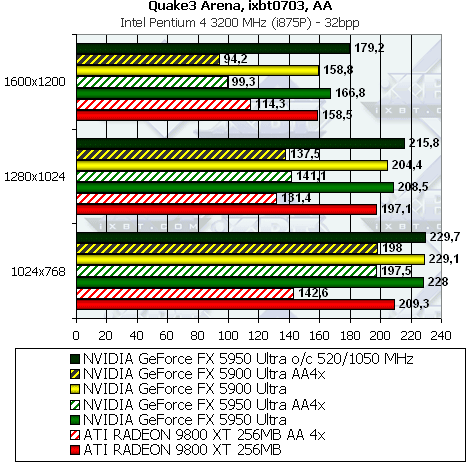
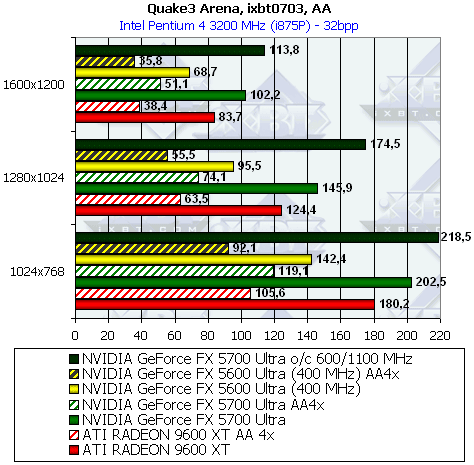
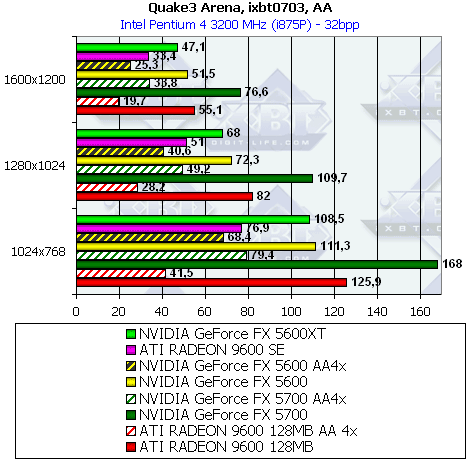
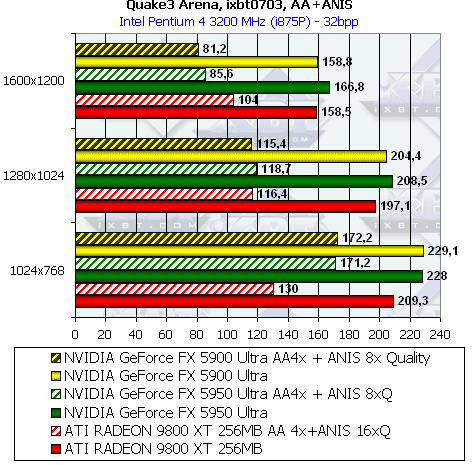
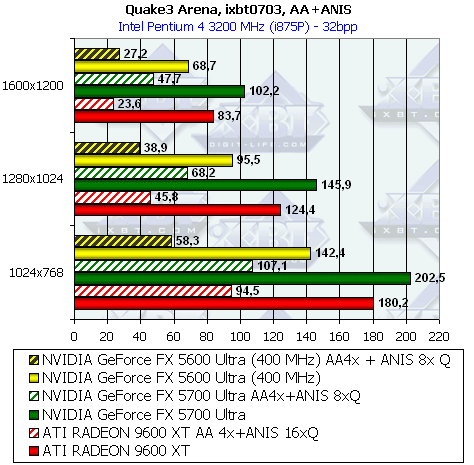
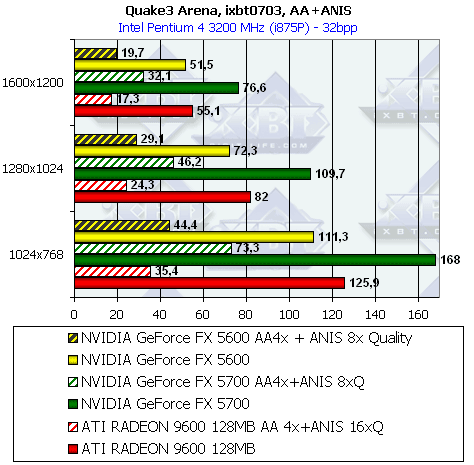
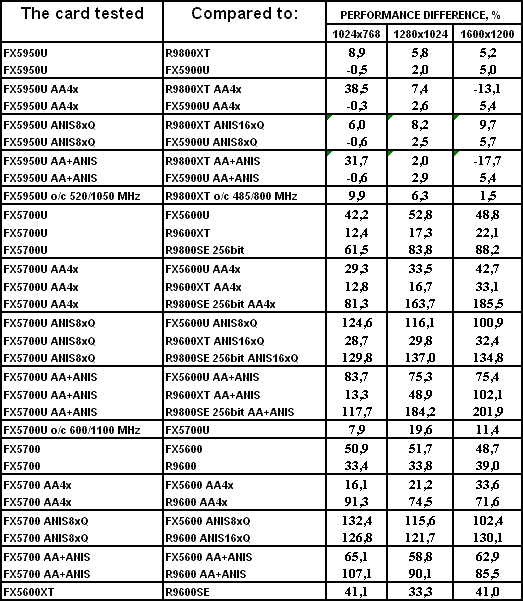
Light modes without AA and anisotropy: the FX 5950 Ultra
easily beats its
competitor from ATI's camp. The FX5700 Ultra, FX5700, and FX5600XT come
out winners.
AA enabled: the FX5950 Ultra still wins in 1024x768 but in
higher resolutions
the performance gain decreases and in 1600x1200 the card loses. The
FX5700
Ultra wins in all resolutions, so does the FX5700.
Anisotropy enabled: NV38 has a good breakaway, and the success
of the
NV36 is weightier.
AA & anisotropy enabled: the NV38 wins only in 1024x768;
the higher
the resolution, the stronger the RADEON 9800 XT. The NV36 (both cards)
holds the crown reliably.
So:
-
NVIDIA GeForce FX 5950 Ultra - a complicated situation, though it has a
small advantage
-
NVIDIA GeForce FX 5700 Ultra - victory!
-
NVIDIA GeForce FX 5700 - victory!
-
NVIDIA GeForce FX 5600XT 128bit - victory!
|
| RADEON 9800, driver 6.387 |
FX 5900, driver 52.xx |
| No AA, No ANISO |
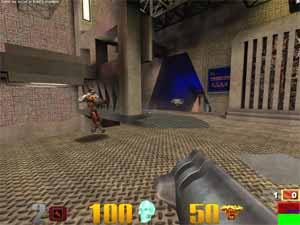
|
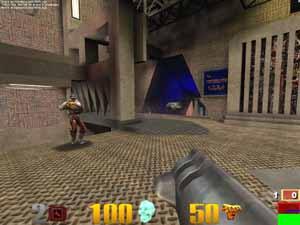
|
| AA4x, ANISO 16xQ/8xQ |
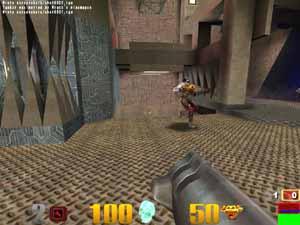
|
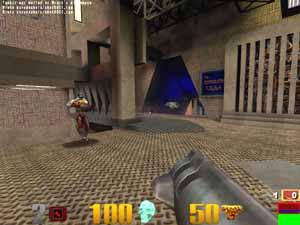
|
|
No complaints about the quality. The FX 5950 doesn't differ from the
5900, all the FX 5700/5600 cards demonstrate the same quality.
Serious Sam: The Second Encounter
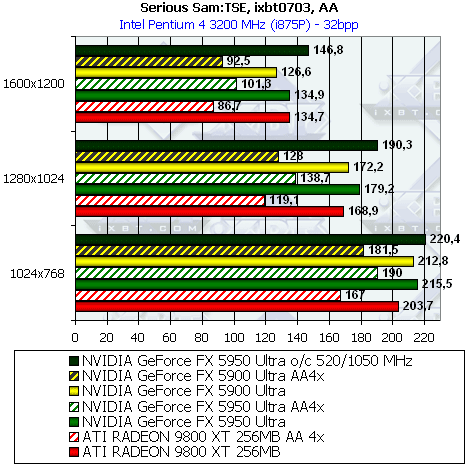
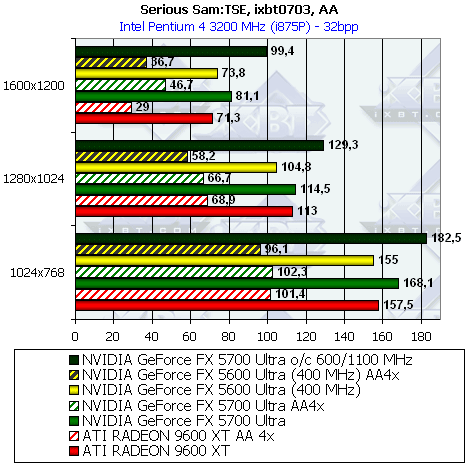
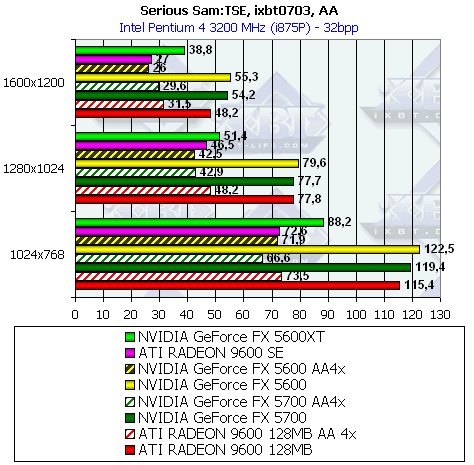
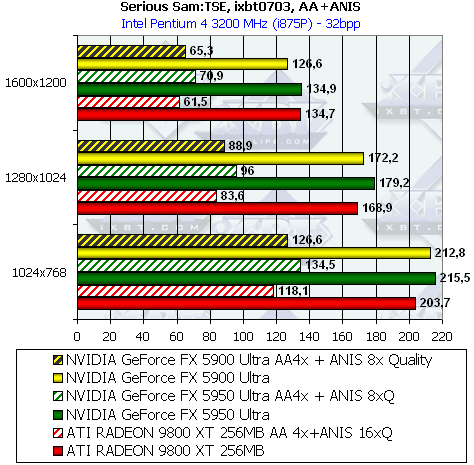
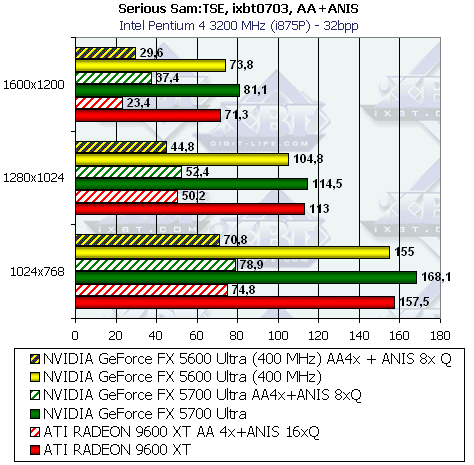
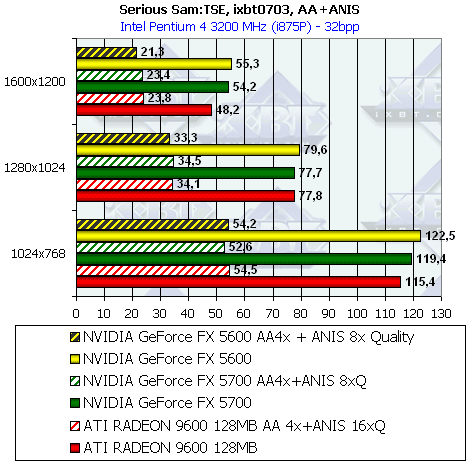
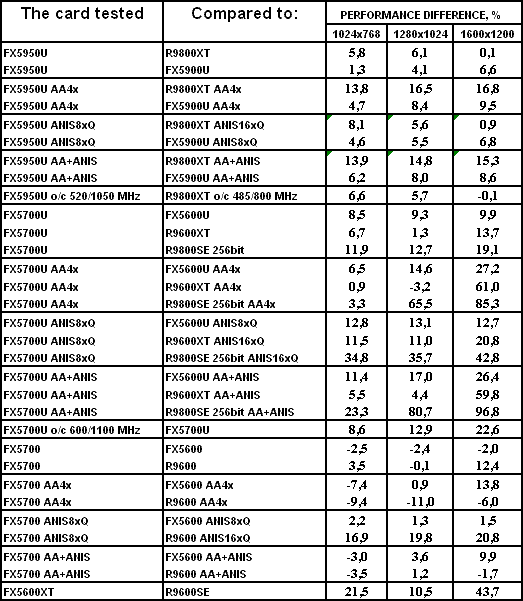
Light modes without AA and anisotropy: the NV38 and NV36
outscore their
competitors by a little margin. The FX5600XT comes out a winner.
AA enabled: the NV38 as well as the FX5700 Ultra, strengthen
their positions.
The FX5700 loses to the RADEON 9600.
Anisotropy enabled: the FX5950 Ultra easily wins the battle,
and the
NV36 (both cards) look more successful.
AA & anisotropy enabled: the NV38 wins! The FX 5700 Ultra
performs
pretty well, and the FX5700 loses to its competitor.
So:
-
NVIDIA GeForce FX 5950 Ultra - wins
-
NVIDIA GeForce FX 5700 Ultra - wins
-
NVIDIA GeForce FX 5700 - if the FX 5700 is equal to the R9600 PRO in
price,
it will lose the battle
-
NVIDIA GeForce FX 5600XT 128bit - leads the pack
|
| RADEON 9800, driver 6.387 |
FX 5900, driver 52.xx |
| No AA, No ANISO |
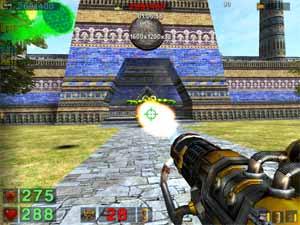
|
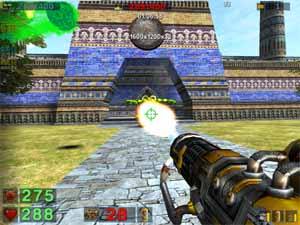
|
| AA4x, ANISO 16xQ/8xQ |
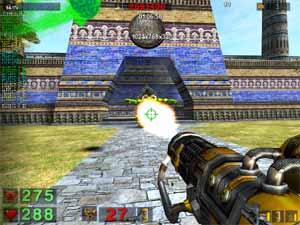
|
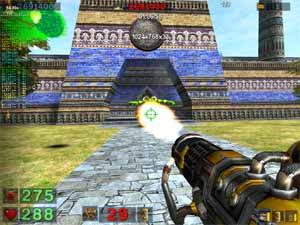
|
|
No complaints about quality (it concerns all FX 5xxx).
Return to Castle Wolfenstein (Multiplayer)
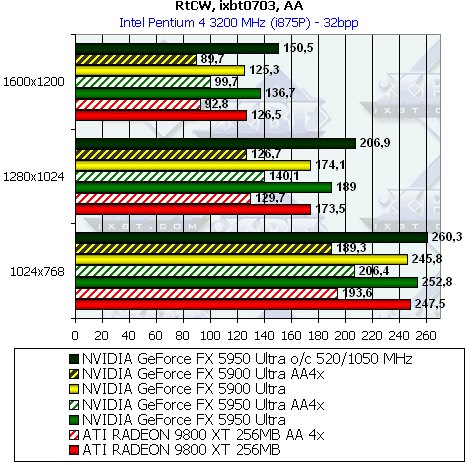
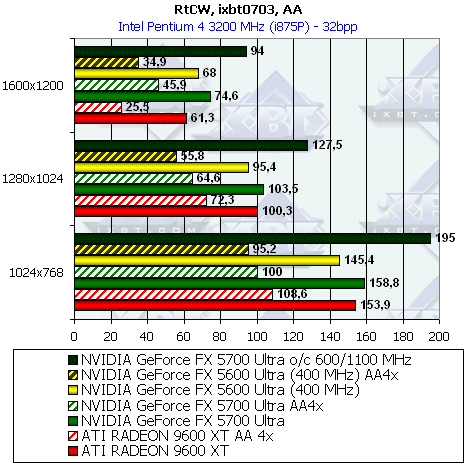
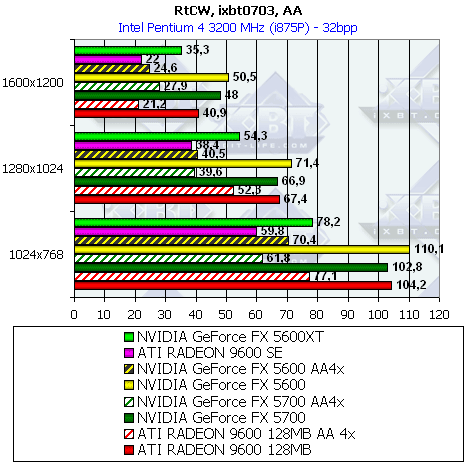
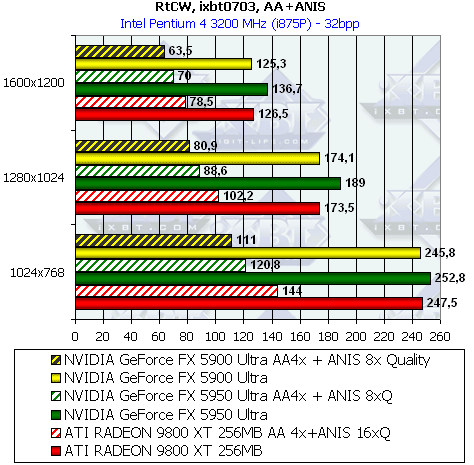
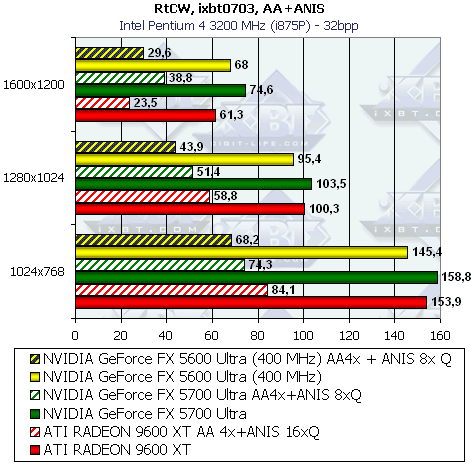
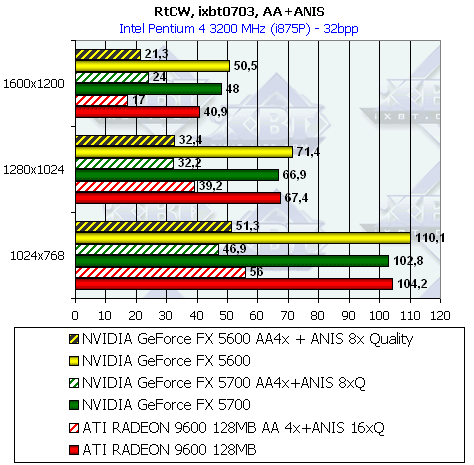
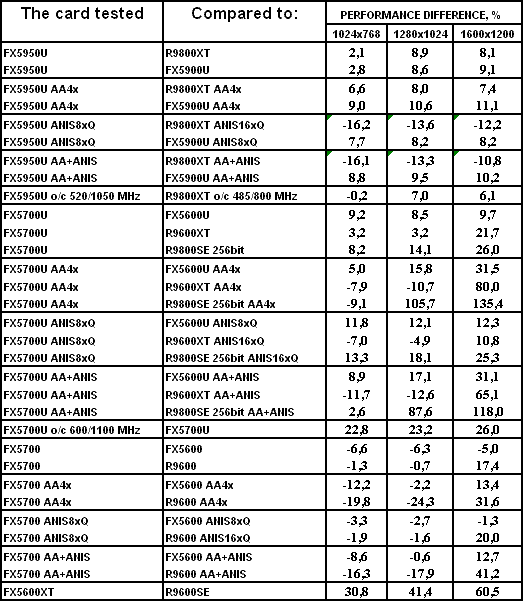
Light modes without AA and anisotropy: the FX 5950 Ultra
easily beats its
competitor from ATI's camp. The FX5700 Ultra outruns the R9600 XT
(though
the breakaway in 1600x1200 is not so great), and FX5600XT also comes
out
a winner. Note that the quality bugs mentioned below are noticed only
in
FX 5900-5950, not in FX 5600-5700.
AA enabled: NV38 demonstrates no changes, NV36 loses the fight
in low
resolutions, but in higher resolutions the memory bus helps the
FX5700/5700
Ultra to grasp the victory. In the low-level sector the FX 5600 XT is
still
ahead.
Anisotropy enabled: NV38 loses this time (NVIDIA probably
forgets about
RtCW from time to time, and some functions work badly: either the speed
is low or the quality is not that good). The NV36 also loses in all
resolutions
except 1600x1200 where it managed to take the lead thanks to its wide
memory
bus.
AA & anisotropy enabled: the NV38 and NV36 lose the
competition
in most resolutions.
So:
-
NVIDIA GeForce FX 5950 Ultra - defeat (complete defeat taking into
account
artifacts in quality)
-
NVIDIA GeForce FX 5700 Ultra - defeat (but not by 100%)
-
NVIDIA GeForce FX 5700 - defeat
-
NVIDIA GeForce FX 5600XT 128bit - victory
|
| RADEON 9800, driver 6.387 |
FX 5900, driver 52.xx |
| No AA, No ANISO |
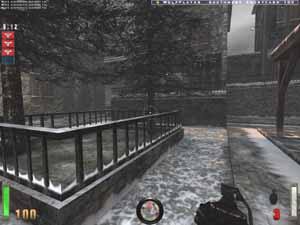
|
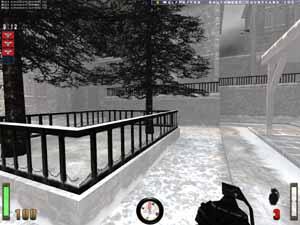
|
| AA4x, ANISO 16xQ/8xQ |
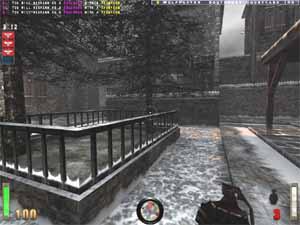
|
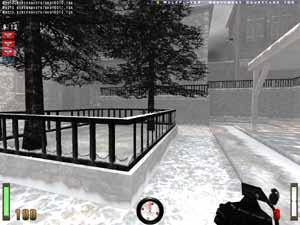
|
|
The error in NVIDIA's driver is not corrected yet. It appears only in
case of the FX 5900-5950.
Code Creatures
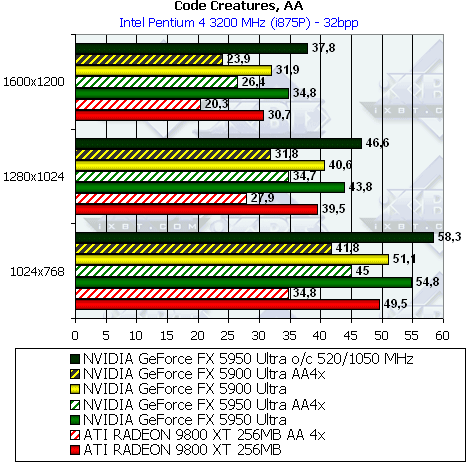
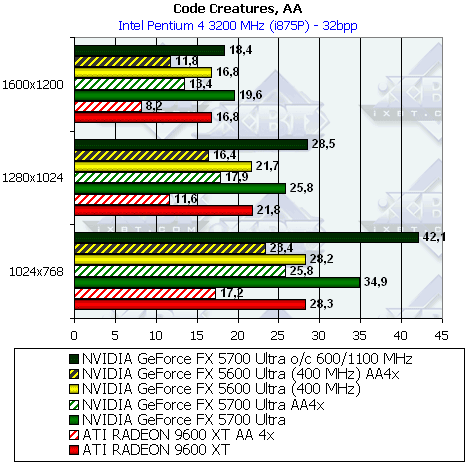
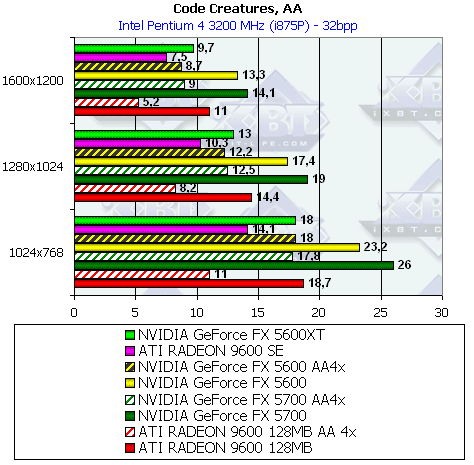
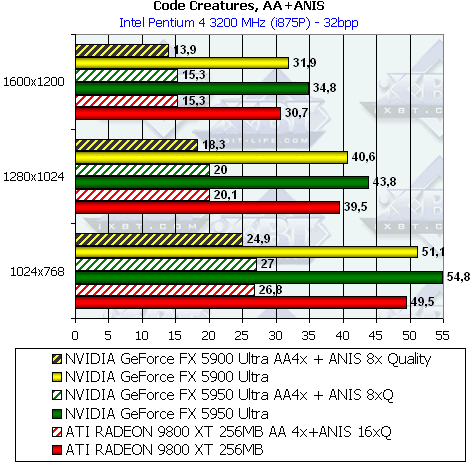
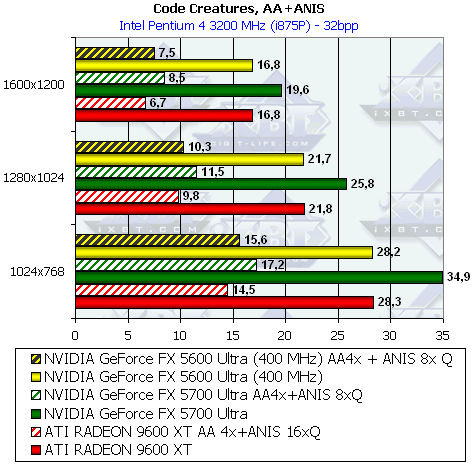
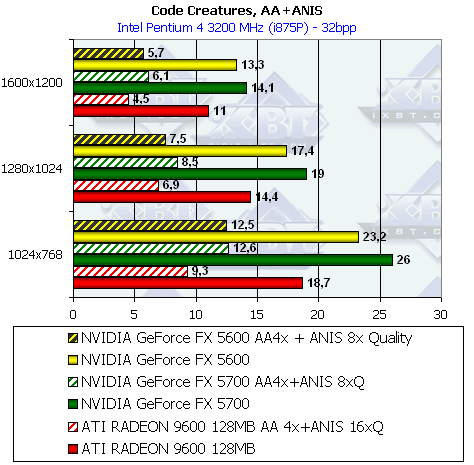
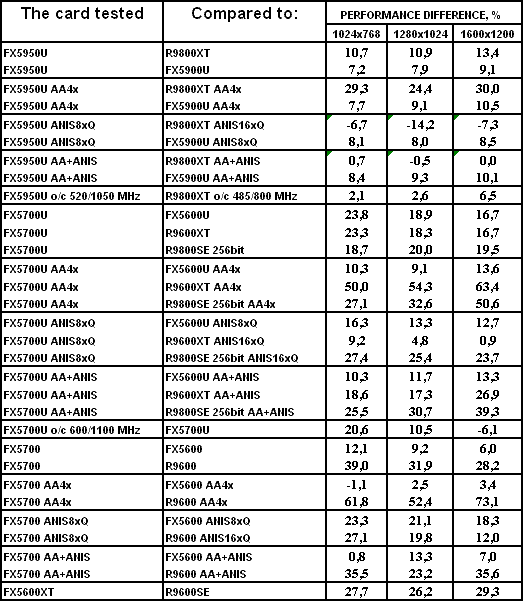
Light modes without AA and anisotropy: the NV38 and NV36
outscore their
competitors by a little margin. The FX5600XT is more successful.
AA enabled: the NV38, as well as the FX5700 Ultra, strengthen
their
positions. The FX5700 goes on a par with the RADEON 9600 (if it has the
same price as the R9600 PRO, it will lose the competition).
Anisotropy enabled: the NV38 loses the battle, though the
FX5950 Ultra
still beats the R9600 XT; the FX 5700 looks better.
AA & anisotropy enabled: the FX 5950 Ultra goes on a par
with the
R9800 XT. The NV36 (both cards) remains a leader.
So:
-
NVIDIA GeForce FX 5950 Ultra - victory, though the gap is not big
-
NVIDIA GeForce FX 5700 Ultra - strong victory
-
NVIDIA GeForce FX 5700 - the same
-
NVIDIA GeForce FX 5600XT 128bit - perfect!
|
| RADEON 9800, driver 6.387 |
FX 5900, driver 52.xx |
| No AA, No ANISO |
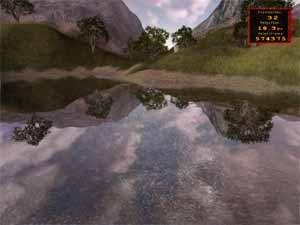
|
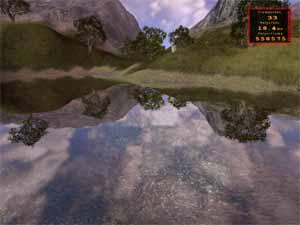
|
| AA4x, ANISO 16xQ/8xQ |
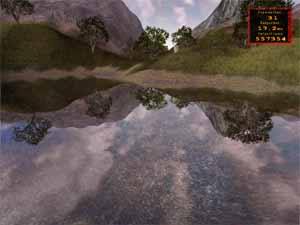
|
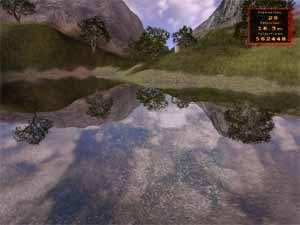
|
|
The picture demonstrated by the RADEON and GeForce differ but I can't
say that one or the other is better. Tastes differ.
Unreal Tournament 2003
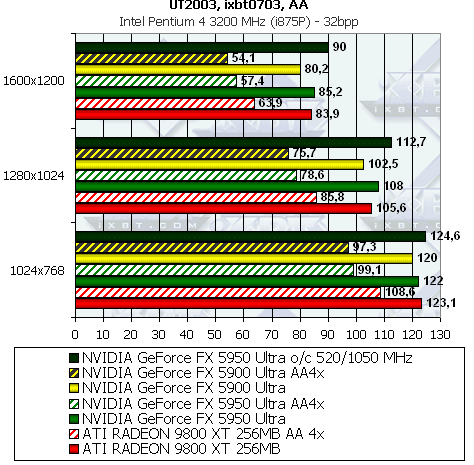
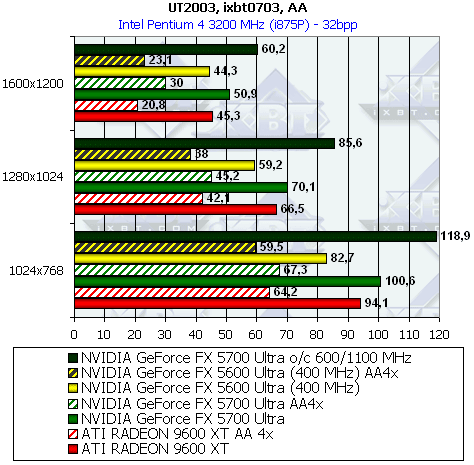
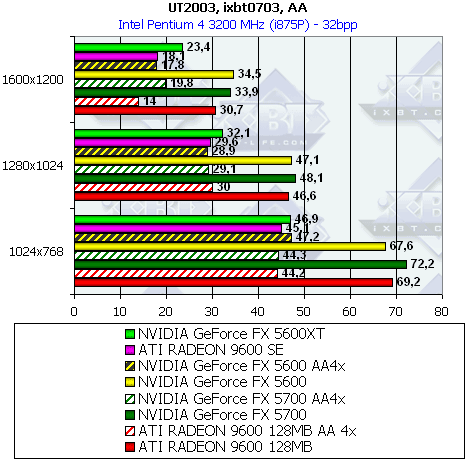
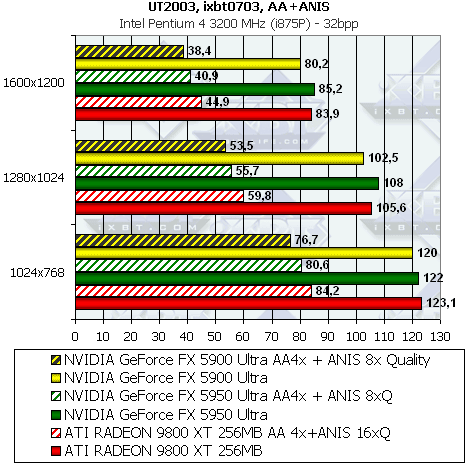
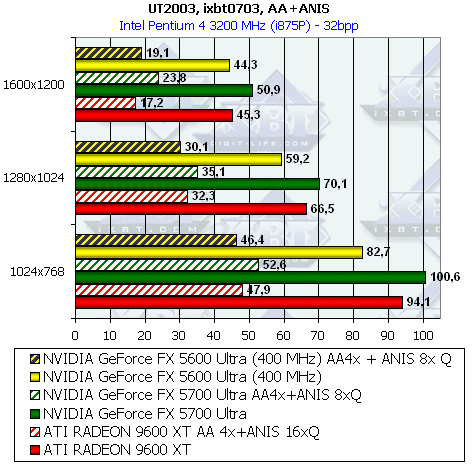
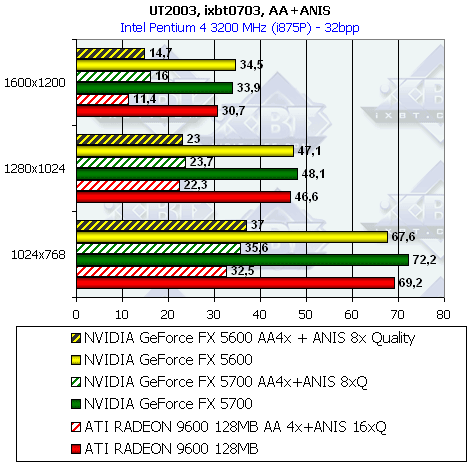
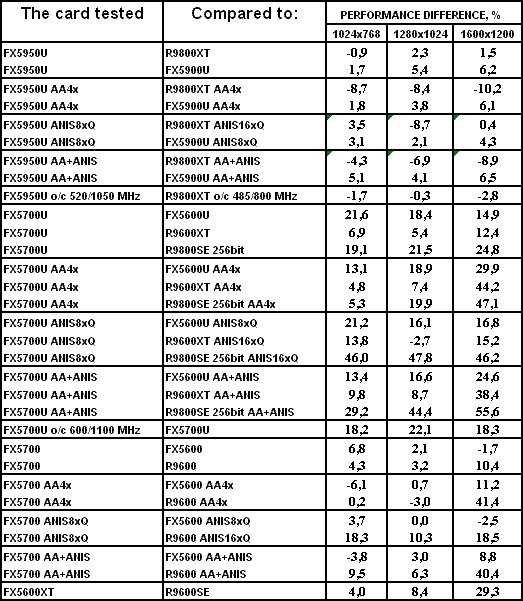
Light modes without AA and anisotropy: the NV38 looks equal to
its competitor,
the NV36 is a little ahead of its counterpart. The FX5600XT comes out a
winner.
AA enabled: the NV38 loses in this test, though both NV36 look
good.
If the RADEON 9600 PRO is comparable in price to the FX 5700, the
latter
will have no chances to succeed.
Anisotropy enabled: the FX5950 Ultra demonstrates parity with
its competitor.
The FX5700 Ultra unexpectedly falls down at 1280x1024, but in general
this
card wins in this test. The FX5700 easily outdoes its competitor.
AA & anisotropy enabled: the NV38 loses and both NV36 win
the competition.
So:
-
NVIDIA GeForce FX 5950 Ultra - defeat
-
NVIDIA GeForce FX 5700 Ultra - victory
-
NVIDIA GeForce FX 5700 - victory
-
NVIDIA GeForce FX 5600XT 128bit - victory
|
| RADEON 9800, driver 6.387 |
FX 5900, driver 52.xx |
| No AA, No ANISO |
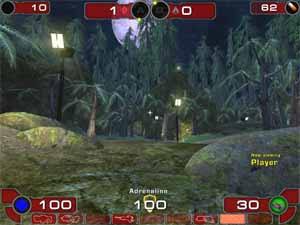
|
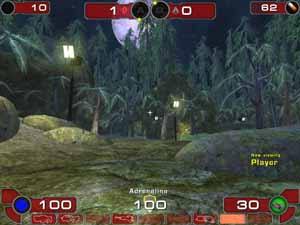
|
| AA4x, ANISO 16xQ/8xQ |
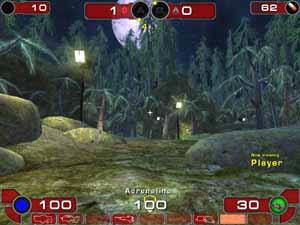
|
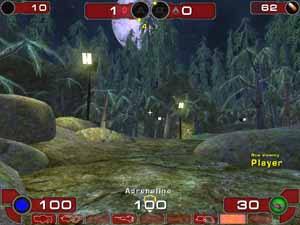
|
|
No complains about the quality. The pictures look identical for the
whole NV3x family.
Unreal II: The Awakening
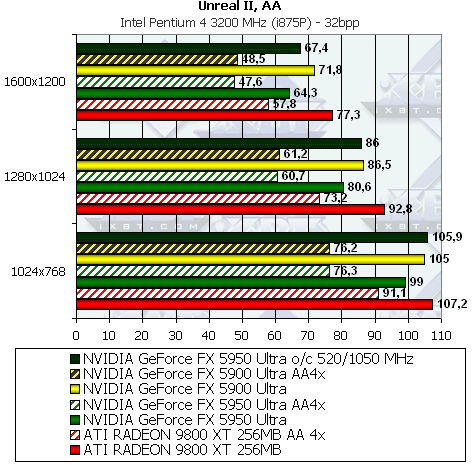

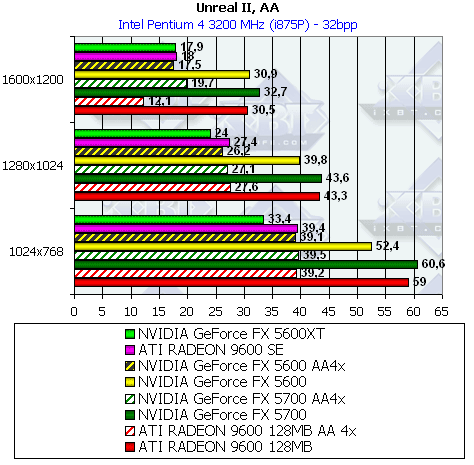

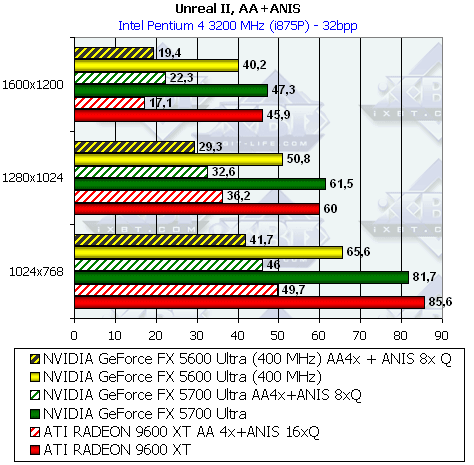
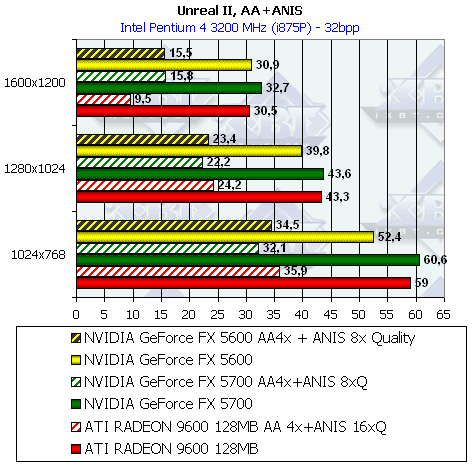

No AA, no anisotropy: the NV38 loses, both NV36 are equal to
their competitors,
the FX 5700 looks more confident. The FX5600 XT loses the battle for
the
first time.
AA enabled: the NV38 loses here. Both NV36 look equal to their
competitors
in the popular modes and take the lead in 1600x1200 thanks to their
memory
bus (but hardly anyone would play in such resolution with AA enabled on
such cards).
Anisotropy enabled: the NV38 performs worse. However, all the
cards
including the NV36 lose this time.
AA & anisotropy enabled: all NVIDIA cards lose in this
mode.
So:
-
NVIDIA GeForce FX 5950 Ultra - defeat
-
NVIDIA GeForce FX 5700 Ultra - defeat
-
NVIDIA GeForce FX 5700 - defeat
-
NVIDIA GeForce FX 5600XT 128bit - defeat
|
| RADEON 9800, driver 6.387 |
FX 5900, driver 52.xx |
| No AA, No ANISO |
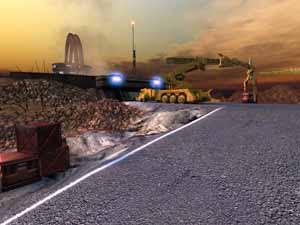
|

|
| AA4x, ANISO 16xQ/8xQ |
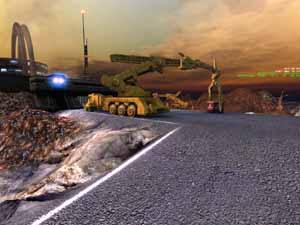
|

|
|
No complaints about the quality.
RightMark 3D
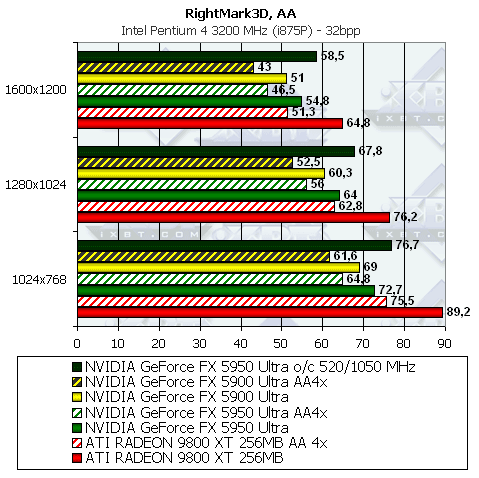
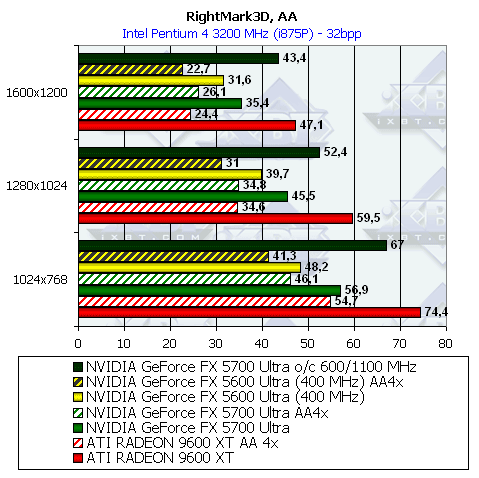
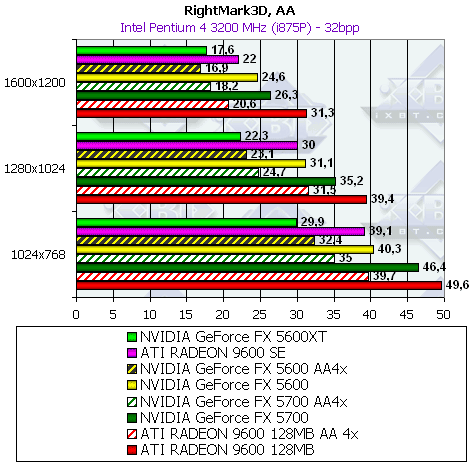
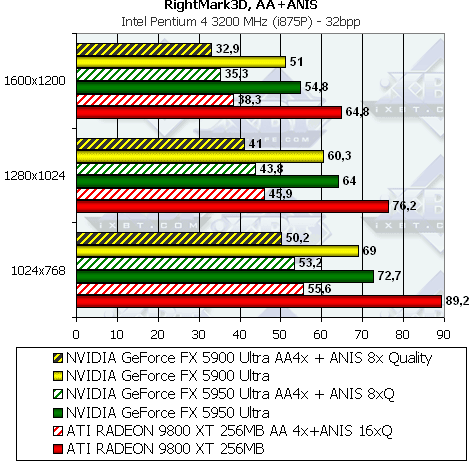


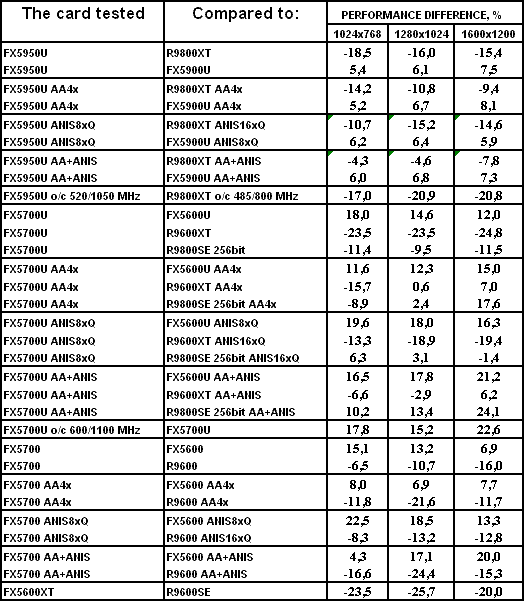
No AA, no anisotropy: the whole NV38/NV36 line loses the
competition, but
shaders were always a problem for the whole NV3x family.
AA enabled: the FX5700 Ultra takes the lead in high
resolutions only
thanks to its memory bus.
Anisotropy enabled: all the NV36/NV38 cards are beaten.
AA & anisotropy enabled: well, I have nothing to add.
So:
-
NVIDIA GeForce FX 5950 Ultra - defeat
-
NVIDIA GeForce FX 5700 Ultra - defeat
-
NVIDIA GeForce FX 5700 - defeat
-
NVIDIA GeForce FX 5600XT 128bit - defeat.
|
| RADEON 9800, driver 6.387 |
FX 5900, driver 52.xx |
| No AA, No ANISO |
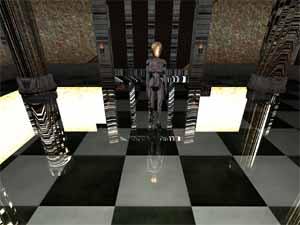
|
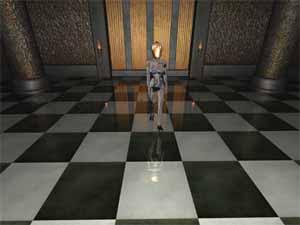
|
| AA4x, ANISO 16xQ/8xQ |
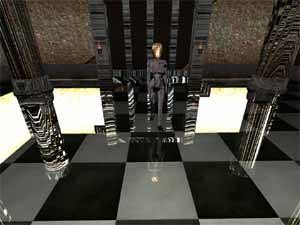
|
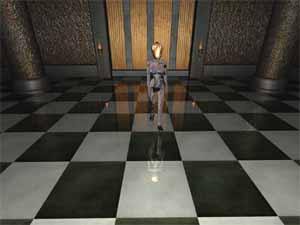
|
|
Look at the bugs in this test with the ATI driver 3.8! The programmers
are already informed about it, and we hope that the next time it will
be corrected. However, judging by the previous tests where we had no
complaints about the quality, the RADEONs look superior. Users do blame
the driver v3.8 - how dare they release so raw drivers and in the
WHQL pack!
TR:AoD, Paris5_4 DEMO

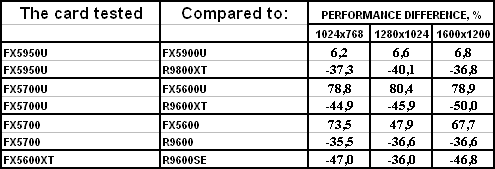
Shader test... well, all the cards lose here.
So:
-
NVIDIA GeForce FX 5950 Ultra - defeat
-
NVIDIA GeForce FX 5700 Ultra - defeat
-
NVIDIA GeForce FX 5700 - defeat
-
NVIDIA GeForce FX 5600XT 128bit - defeat.
Quality was already examined, I have no complaints about it.
TR:AoD, Paris1c DEMO


There are fewer shaders, and the NV3x come closer to their
competitors,
though they are still behind them.
So:
-
NVIDIA GeForce FX 5950 Ultra - outsider
-
NVIDIA GeForce FX 5700 Ultra - outsider
-
NVIDIA GeForce FX 5700 - outsider
-
NVIDIA GeForce FX 5600XT 128bit - outsider
TR:AoD, Paris2g DEMO
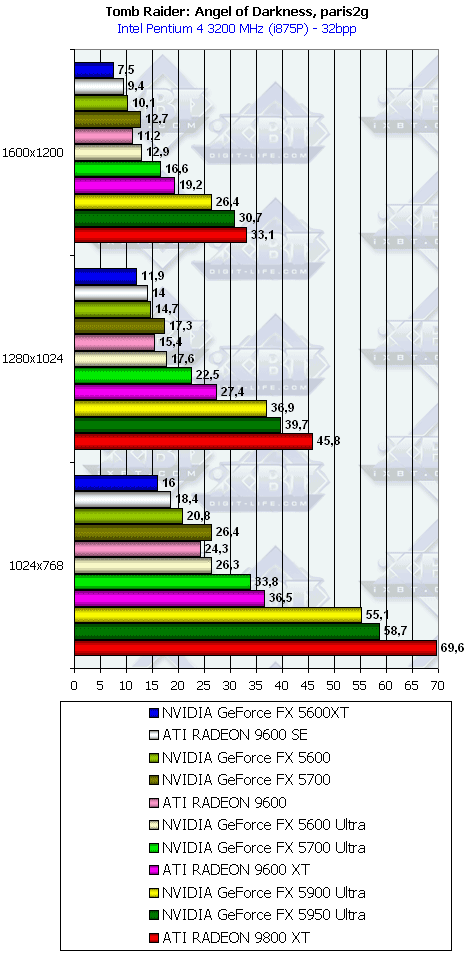

There are almost no shaders, and the FX 5700 grasps the palm.
But the NV3x
family generally loses this battle.
So:
-
NVIDIA GeForce FX 5950 Ultra - defeat
-
NVIDIA GeForce FX 5700 Ultra - defeat
-
NVIDIA GeForce FX 5700 - victory(!)
-
NVIDIA GeForce FX 5600XT 128bit - defeat
HALO: Combat Evolved
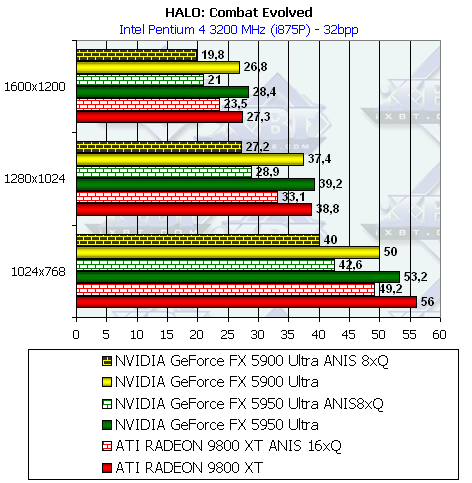


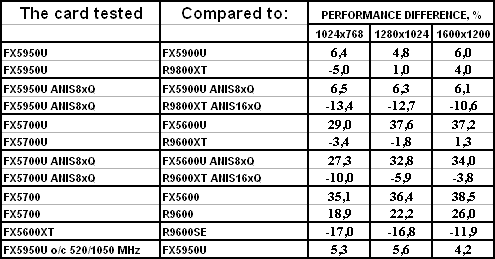
No AA, no anisotropy: the NV38 goes on a par with the R9800XT;
FX5700 Ultra
is beaten while the FX5700 takes the lead and outdoes even the R9600
PRO.
Unfortunately, the FX5600 XT is smashed to pieces.
Anisotropy enabled: NV38, as well as the FX5700 Ultra, lose
this round.
So:
-
NVIDIA GeForce FX 5950 Ultra - defeat
-
NVIDIA GeForce FX 5700 Ultra - arguable
-
NVIDIA GeForce FX 5700 - victory
-
NVIDIA GeForce FX 5600XT 128bit - defeat
Note that this game doesn't support AA.
|
| RADEON 9800, driver 6.387 |
FX 5900, driver 52.xx |
| Example 1 |
| No AA, No ANISO |
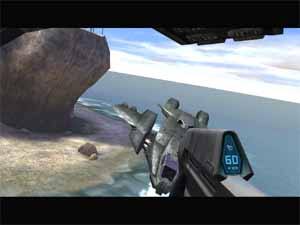
|
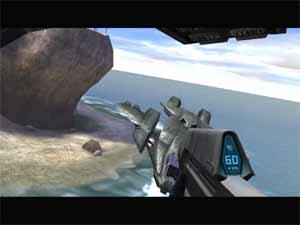
|
| ANISO 16xQ/8xQ |
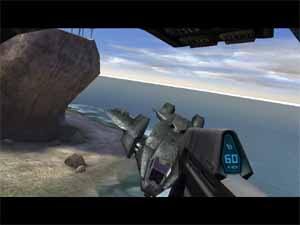
|
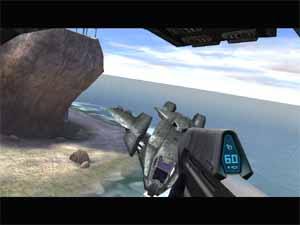
|
| Example 2 |
| No AA, No ANISO |

|

|
| ANISO 16xQ/8xQ |

|

|
| Example 3 |
| No AA, No ANISO |
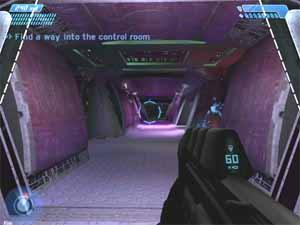
|
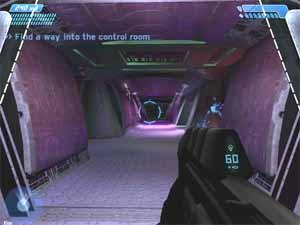
|
| ANISO 16xQ/8xQ |
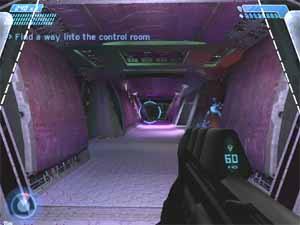
|
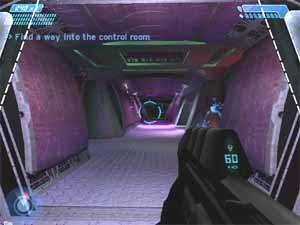
|
|
The quality is good but only in Examples 1 and 2. In Example 3 the
GeForce FX hasn't rendered several light sources.
Half-Life2 (beta): ixbt07 demo
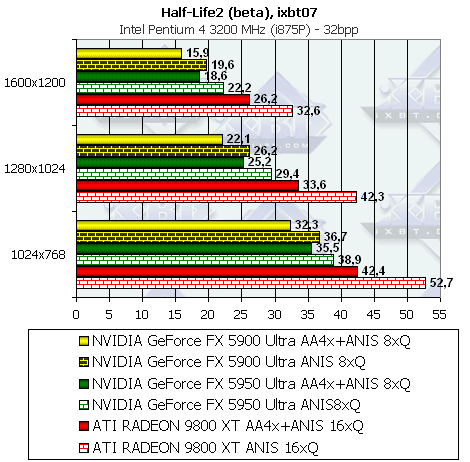
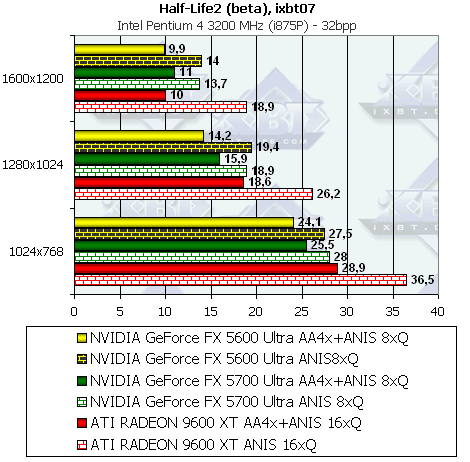
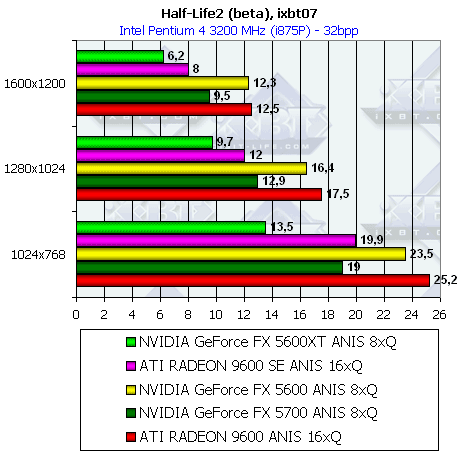
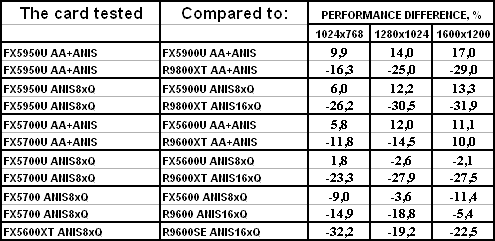
I don't include these scores into the overall results as this
game version is not finished.
|
| RADEON 9800, driver 6.387 |
FX 5900, driver 52.xx |
| Example 1 |
| AA4x, ANISO 16xQ/8xQ |
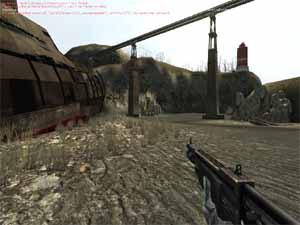
|
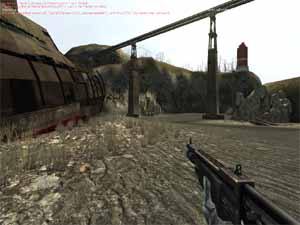
|
| Example 2 |
| AA4x, ANISO 16xQ/8xQ |
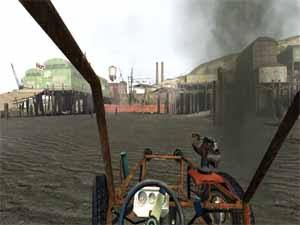
|
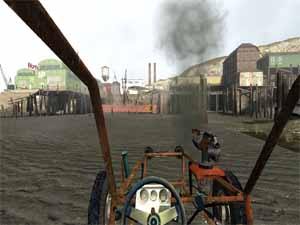
|
| Example 3 |
| AA4x, ANISO 16xQ/8xQ |

|

|
| Example 4 |
| AA4x, ANISO 16xQ/8xQ |
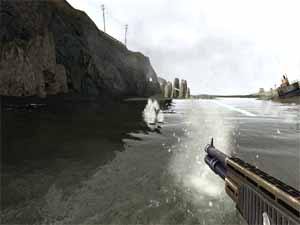
|
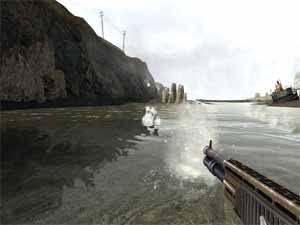
|
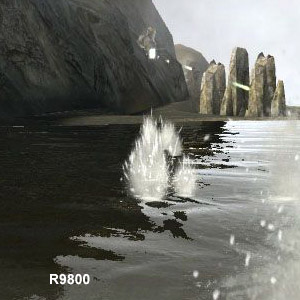
|
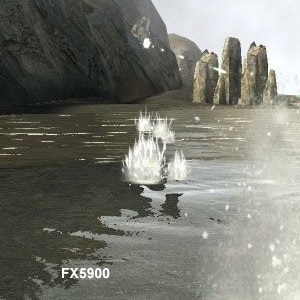
|
|
In case of the FX 59xx at the distance of two MIP levels there's
blurred strip on the water that removes reflections. There's no such
problem with the FX 5600-5700.
Half-Life2 (beta): coast demo
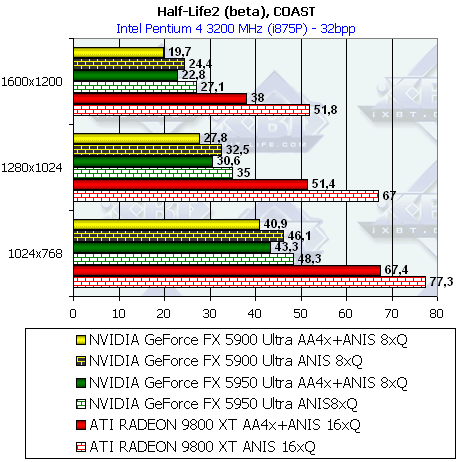
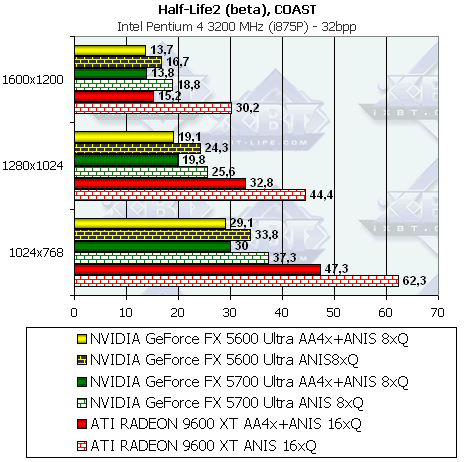
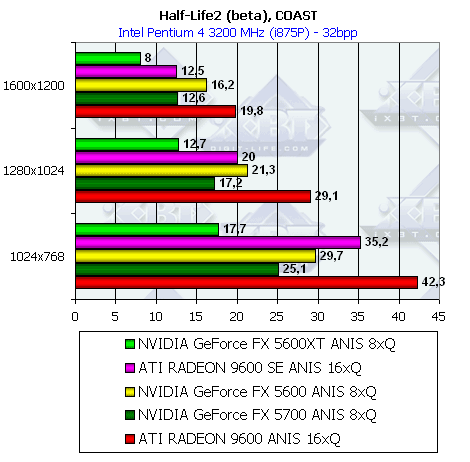
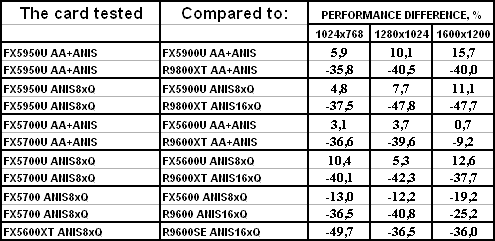
I didn't analyze the results.
|
| RADEON 9800, driver 6.387 |
FX 5900, driver 52.xx |
| Example 1 |
| AA4x, ANISO 16xQ/8xQ |
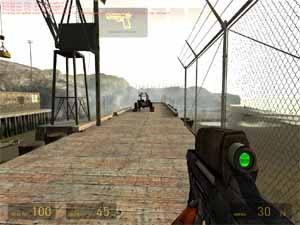
|
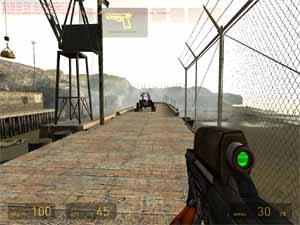
|
| Example 2 |
| AA4x, ANISO 16xQ/8xQ |
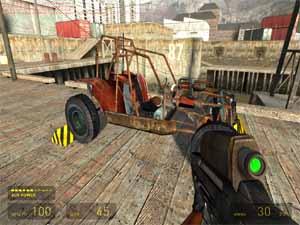
|
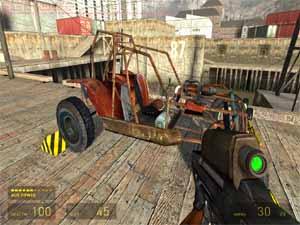
|
| Example 3 |
| AA4x, ANISO 16xQ/8xQ |

|

|
| Example 4 |
| AA4x, ANISO 16xQ/8xQ |
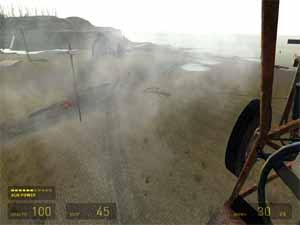
|
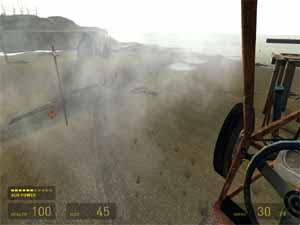
|
Conclusion
So, we have tested the new solutions from NVIDIA, though most
of them are
just overclocked versions of the old GPUs. But the NV36 is a fully
redesigned
chip.
NVIDIA is mostly aimed at the wide penetration of the
mid-level market
with its GeForce FX 5700/5700 Ultra cards, while the NV38 was released
just to improve the company's image.
-
NVIDIA GeForce FX 5950 Ultra is the most powerful 3D solution from
NVIDIA.
Scores:
-
Quake3 Arena v.1.17 - wins
-
Serious Sam: The Second Encounter v.1.07 - wins
-
Return to Castle Wolfenstein (MultiPlayer) - defeat
-
Code Creatures Benchmark Pro - wins
-
Unreal Tournament 2003 v.2225 - defeat
-
Unreal II: The Awakening - defeat
-
RightMark 3D v.0.4 - defeat
-
Tomb Raider: Angel of Darkness v.49 - defeat
-
HALO: Combat Evolved (Microsoft) - defeat
Summary: this card is approximately equal to its competitor taking into
account that shader games are not widely popular yet. But if price of NV38 will
be $399 (not $499) and if the price
gap remains the same, the NV38 will beat the other as all advantages of the
R9800XT in the shader speed are not worth paying $100. I repeat: only if price
will be lower then $499.
- NVIDIA GeForce FX 5700 Ultra is an interesting solution. It
targets the
middle sector having the expensive PCB and GDDR2 memory. Scores:
-
Quake3 Arena v.1.17 - wins
-
Serious Sam: The Second Encounter v.1.07 - wins
-
Return to Castle Wolfenstein (MultiPlayer) - defeat
-
Code Creatures Benchmark Pro - wins
-
Unreal Tournament 2003 v.2225 - wins
-
Unreal II: The Awakening - defeat
-
RightMark 3D v.0.4 - defeat
-
Tomb Raider: Angel of Darkness v.49 - defeat
-
HALO: Combat Evolved (Microsoft) - depends on price
Summary: it generally beats the RADEON 9600 XT. The final verdict will
be made when both products reach the store shelves.
- NVIDIA GeForce FX 5700 is a mainstream solution. Scores:
-
Quake3 Arena v.1.17 - wins
-
Serious Sam: The Second Encounter v.1.07 - equal to the RADEON 9600 (if
the price for the RADEON 9600 PRO falls to $140-150, the card will lose
the battle)
-
Return to Castle Wolfenstein (MultiPlayer) - defeat
-
Code Creatures Benchmark Pro - wins
-
Unreal Tournament 2003 v.2225 - wins
-
Unreal II: The Awakening - defeat
-
RightMark 3D v.0.4 - defeat
-
Tomb Raider: Angel of Darkness v.49 - defeat
-
HALO: Combat Evolved (Microsoft) - wins
-
AquaMark3 (Massive Development) - wins
Summary: it looks quite good compared to the RADEON 9600, but if the
prices
for the R9600/9600 PRO keep on falling down and the 9600 PRO gets equal
to the FX 5700, ATI's solution can become more attractive. Well, let's
wait for the real cards and prices. Remember that we estimate its
performance
on the basis of the FX 5700 Ultra card running at the lower clock
speed,
and the FX 5700 can have different scores.
- NVIDIA GeForce FX 5600XT 128bit is NVIDIA's attempt to
bring onto the
low-end market a more efficient solution than the GeForce FX 5200. The
outcome will also depend on the prices. We compare the card to the
RADEON 9600 SE which has a 64bit bus but we also expect FX 5600XT
64bit cards. We will examine such cards as soon as they come onto the
scene. Scores:
-
Quake3 Arena v.1.17 - wins
-
Serious Sam: The Second Encounter v.1.07 - wins
-
Return to Castle Wolfenstein (MultiPlayer) - wins
-
Code Creatures Benchmark Pro - wins
-
Unreal Tournament 2003 v.2225 - wins
-
Unreal II: The Awakening - defeat
-
RightMark 3D v.0.4 - defeat
-
Tomb Raider: Angel of Darkness v.49 - defeat
-
HALO: Combat Evolved (Microsoft) - defeat
-
AquaMark3 (Massive Development) - defeat
First of all, we tested not a real card but the FX 5600 at
lower clock
speeds, and the scores of the real FX 5600XT 128bit can differ.
Secondly, the FX 5600XT 128bit is obviously a leader in no-shader
games. But the card was released to make DX9 more popular in the
low-end segment. That is why the final verdict will be made when the
cards come onto the scene (also remember that we expect 5600XT 64bit
cards as well).
.
In closing I should say that NVIDIA's new price policy can have a bad
effect
on the competitor. The GeForce FX
5700 Ultra, which looks also good compared to the RADEON 9600XT, has
the
equal recommended price of $199. It's only the FX 5700 which at its
price
of $149 can look equal or a bit inferior to its competitors. Let's wait
for the real cards and their prices which are expected in 3-4 weeks.
In our 3Digest you can
find full comparison characteristics for video cards of this and other
classes.
Write a comment below. No registration needed!
|
|
 |
|
|
|



